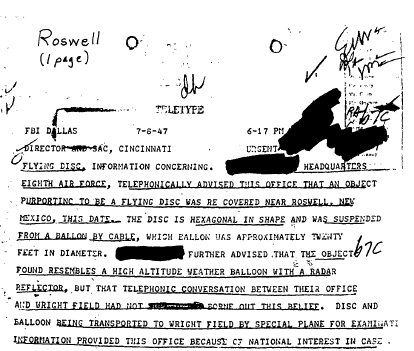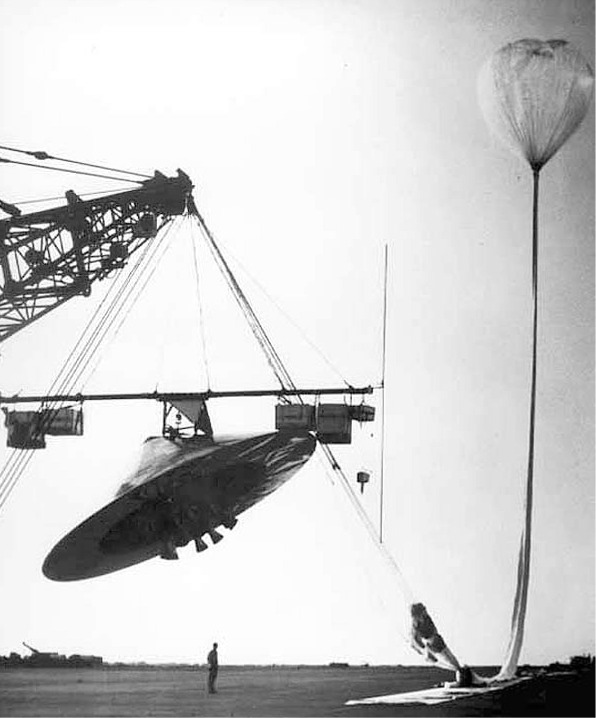The 1947 event at Roswell, NM was one of the sub-plots of Mike’s novel, The Facade. The same was true of the MAJESTIC Documents, part of UFO lore since the 1980s, and used by many in defense of an extraterrestrial explanation for what happened at Roswell.
The view taken in The Facade is that the Roswell crash of July 2, 1947 was in fact a PAPERCLIP accident.

Typically, one side of the Roswell case argues that nothing but a weather balloon crashed that day, while the other side insists that only a MOGUL balloon was recovered. The Facade argues that the data on both sides is valid, but needs a completely different context and approach.
As the de-classified memo on the right–dated July 8, 1947–clearly shows, a disk “suspended from a balloon by cable” was really what was recovered. The photo on the left (from a later date) is truly worth a thousand words of description.
The Facade argues that the object recovered at Roswell was an experimental craft modeled after flying disks designed during WWII by Nazi engineers. Under OPERATION: PAPERCLIP, the designs and the know-how were exported to the U.S. via some of the same Nazi technicians who had begun the project in Germany.

There was, therefore, some sort of connection between MAJESTIC-12 and PAPERCLIP. The Facade further argues that the bodies recovered at the crash were human unfortunates (Mongoloids, Asians, progeria victims, etc.) deemed “worthy” of the kind of human experimentation required for testing high altitude craft. For some documentation of these points, see the links.
* 1946 military report cover documenting US military use of Nazi flying craft technology prior to Roswell.
* Documentation on “human mutations” (human unfortunates like mongoloid children, progeria victims – mistaken for aliens at Roswell) is provided in Nick Redfern’s new book Body Snatchers in the Desert. Click here for Mike’s review of Nick Redfern’s book.
* Documentation in general of US human experimentation
Testing the MAJESTIC Documents
In 2007, with the help of Dr. Carol Chaski, an expert in computational linguistic research methods for testing authorship verification of documents, the MAJESTIC Documents were scientifically tested for the first time using modern computational linguistic software. A summary analysis of the results of the testing are available here. One paragraph of that report reads as follows”
“The goal of the research presented in this study was to determine whether the Majestic documents that carry a signature were indeed written by the people to whom authorship is attributed. Toward achieving this goal, the study employed state-of-the-art computational linguistic methods of authorship attribution. In some cases, these techniques have been pioneered by Dr. Carol Chaski, a recognized leader in this type of linguistic research.”


